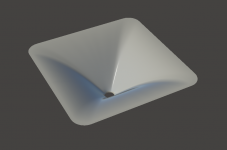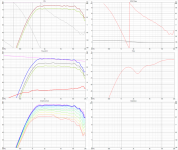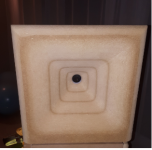You need to create a directory "D:\Horns" or change the cfg script to point to an existing directory.
Its this line "Out.DestDir = "D:\Horns"
Its this line "Out.DestDir = "D:\Horns"
I apologize if this has been asked before, but can this software simulate the diffraction effects and/or off-axis response from something like the DXT “lens” over a dome tweeter?
1) The Seas DXT tweeter uses a waveguide, not a lens
2) You can simulate it's diffraction using AxiDriver, because the waveguide is symmetrical
2) You can simulate it's diffraction using AxiDriver, because the waveguide is symmetrical
Very nice!
1 measured free standing, baffle or IB?
2. What throat angle was used to match 1095?
1 measured free standing, baffle or IB?
2. What throat angle was used to match 1095?
It's not mine so I don't know the details, I'm only reporting the success - it would be a pity not to do so. 🙂
The angle should be 27 deg. If the guys are reading it here, they can chime in anytime.
The angle should be 27 deg. If the guys are reading it here, they can chime in anytime.
Okey, yes it looks very nice.
Would be usefull to know the ATH parameters and measurement conditions. DI looks quite low, at about 5, could be nice with a cardioid 12” mid bass? Isn’t cardioid and dipole around DI 4.8?
Would be usefull to know the ATH parameters and measurement conditions. DI looks quite low, at about 5, could be nice with a cardioid 12” mid bass? Isn’t cardioid and dipole around DI 4.8?
I wouldn't take the DI shown at a face value. It may be a bit lower than usual because of the slightly wider beamwidth, that's true. It's also for the front hemisphere only. I can imagine mating this particular design with almost anything.
On behalf of Michal, who did that WG and measurements, intended just as the first proto verification of WG/driver combo.
Measurement conditions:
- WG was standing on the box of the same width as WG
- mic distance 1m
- measured indoor
- smoothing 1/12
- gating 4ms
Measurement conditions:
- WG was standing on the box of the same width as WG
- mic distance 1m
- measured indoor
- smoothing 1/12
- gating 4ms
Yet another horn (measured). It's around 12" in size, 100° coverage, somewhat bigger A9, 18Sound NSD1095N.
Made with Ath4. See how easy it is... 🙂
Have you put any thought into creating a DXT-style diffracting waveguide for the SB26ADC? That's exactly what I'd like to do but if you've already done it, I'll just save myself the time...
I have a nearfield monitoring application where I would like the full spectrum off-axis response up to 30 degrees to be as close as possible to the on-axis response. The DXT tweeter does a great job with dispersion up to ~20 kHz but unfortunately does not have good distortion performance below about 1.4 kHz, which is also what I need.
I have a nearfield monitoring application where I would like the full spectrum off-axis response up to 30 degrees to be as close as possible to the on-axis response. The DXT tweeter does a great job with dispersion up to ~20 kHz but unfortunately does not have good distortion performance below about 1.4 kHz, which is also what I need.
Last edited:
I could probably throw together a waveguide for the SB26ADC in about one hour, using the methodology here :
3D Modeling Tips and Tricks
But you'd need a way to print it.
Also, I've generally found that any dome over about 3/4" works poorly on waveguides, due to the geometry. (The tip of the dome is too far away from the edge of the dome, causing a high frequency dip as illustrated here : David Ralph's Speaker Pages - Projects )
But if you have a 3D printer, might be worth a shot.
3D Modeling Tips and Tricks
But you'd need a way to print it.
Also, I've generally found that any dome over about 3/4" works poorly on waveguides, due to the geometry. (The tip of the dome is too far away from the edge of the dome, causing a high frequency dip as illustrated here : David Ralph's Speaker Pages - Projects )
But if you have a 3D printer, might be worth a shot.
Have you put any thought into creating a DXT-style diffracting waveguide for the SB26ADC?
Follow John's earlier advice and try the SB19ST-C000-4 instead. This tweeter has lower THD in a waveguide I designed at 1KHz than a BMS4552. I cross it at 1.1KHz in a MEH. Response was smoother than the BMS as well.
Interesting... at 95 dB/1 m, the SB26ADC is ~68 dB down for both H4 and H5 at 1 kHz. I would be very very surprised if the SB19ST was as good.Follow John's earlier advice and try the SB19ST-C000-4 instead. This tweeter has lower THD in a waveguide I designed at 1KHz than a BMS4552. I cross it at 1.1KHz in a MEH. Response was smoother than the BMS as well.
I could get someone locally to do it for me, or heck, bite the bullet and buy a printer for myself.I could probably throw together a waveguide for the SB26ADC in about one hour, using the methodology here :
3D Modeling Tips and Tricks
But you'd need a way to print it.
Seas uses a 1" dome for their DXT, and the response comes out looking perfect. Perhaps the protective mesh helps?
- Home
- Loudspeakers
- Multi-Way
- Acoustic Horn Design – The Easy Way (Ath4)


